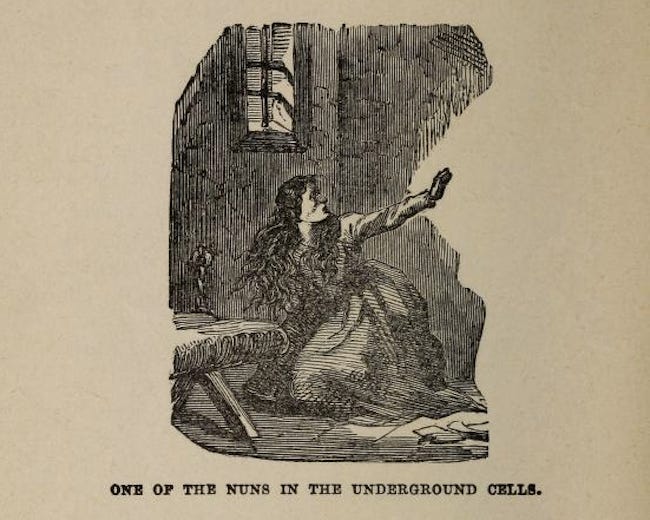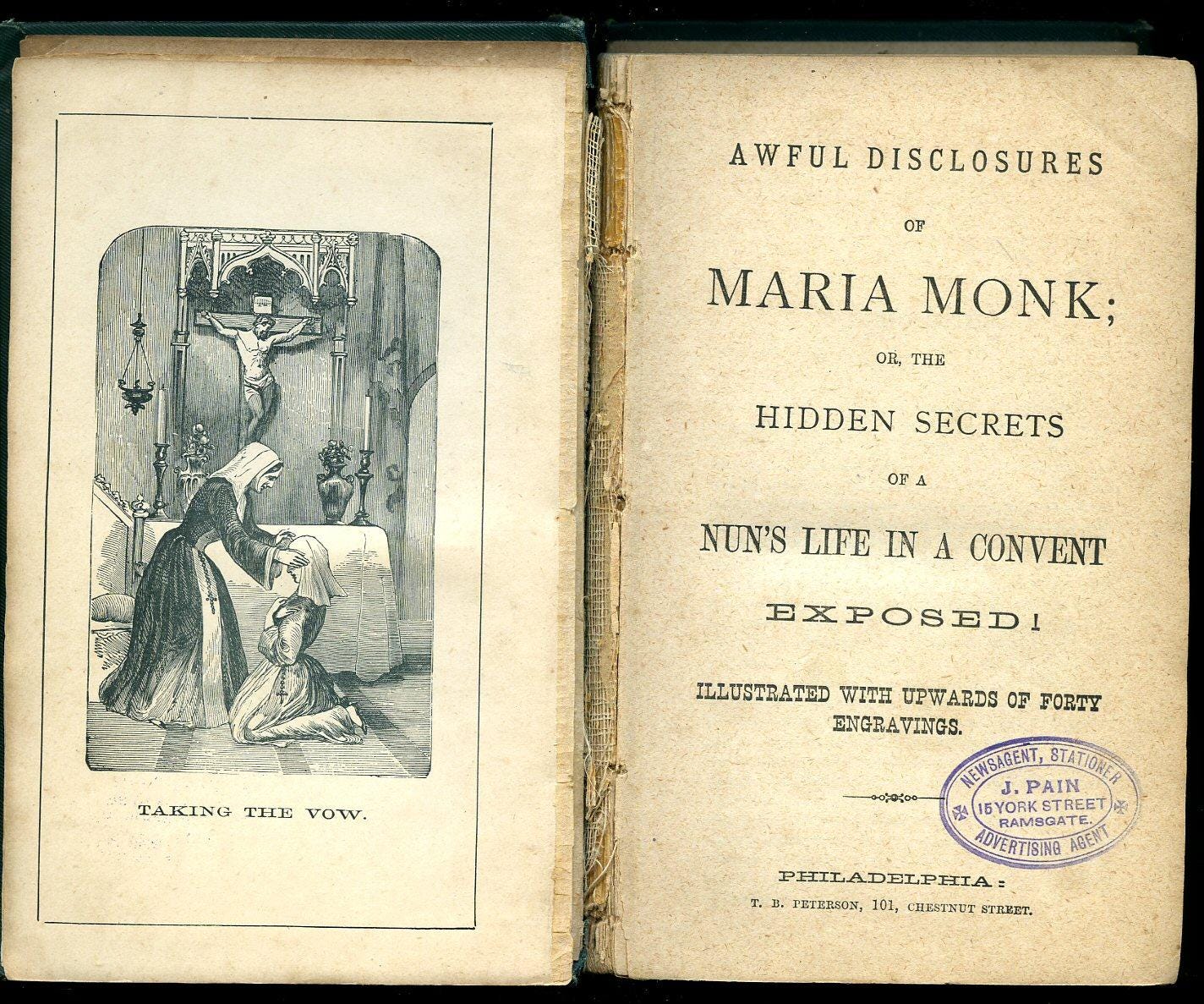The details are lurid. A global organization kidnaps children and teens (especially young girls) to have sex with power-hungry men in secret locations, men who are also involved in a traitorous plot to undermine democracy. If the girls become pregnant, their infants are murdered and their bones and blood mixed into the unholy sacraments of a Satanic cult. If a girl resists, she disappears - her fate unknown.

If you think I’ve been spending time online reading QAnon conspiracy theories, you’re wrong. This is the plot of a book published in 1836: The Awful Disclosures of Maria Monk, or, The Hidden Secrets of a Nun’s Life in a Convent Exposed.
The global organization was, in the case of Maria Monk, the Catholic Church. Monk, a Canadian, claimed all of this had happened in a convent in Montreal. The book caused a public uproar and forced an investigation - the conclusion of which led even local Protestants, who wanted to believe their hated Catholic neighbors were capable of such treachery, to agree the whole thing was a hoax.
The Canadians did their homework. Monk quietly left town and made her way to Philadelphia, where she penned a sequel – Further Disclosures of Maria Monk – for an American audience more receptive to her tales. In 1835, several sensational accounts about the “Catholic threat” appeared. Samuel Morse (the inventor of the telegraph) published Foreign Conspiracies against the Liberties of the United States, accusing the Jesuits of colluding with Austria to install the Hapsburg Emperor as America’s new king.
The Reverend Lyman Beecher (brother of Harriet Beecher Stowe) wrote his Plea for the West, warning American Protestants that the Republic was being threatened by European “potentates” dumping thousands and thousands of impoverished Catholics in the United States – with the effect of filling jails and poorhouses, increasing the taxes paid by law-abiding Protestants to care for the indigent, and forming a “papist” voting block.
Also in 1835, Rebecca Reed, a young Episcopal woman from Boston, published Six Months in a Convent. Reed had attended a Catholic school in 1831 and became intensely attracted to Catholicism. She expressed her desire to be a nun, and she entered the convent. Instead of finding spiritual contentment, however, Reed claimed the nunnery was a prison – including spying, near-torturous punishments for those who questioned authority, a Nurse Ratched-like Mother Superior, and a Bishop who “caressed” his favorite young nuns. Reed’s book outdid both Morse and Beecher - Six Months sold 50,000 copies in its first year.

Rebecca Reed invented the modern American conspiracy theory: the gothic mix of innocence threatened at the whim of a vast network of powerful men, political intrigue, a secretive religion, and sex. Maria Monk followed up in 1836 – adding the harem and cannibalism. Monk’s book rivaled Reed’s in popularity, and Awful Disclosures would go on to be one of the most widely read books in pre-Civil War America, outsold only by Uncle Tom’s Cabin.

This might be a nothing more than an obscure lesson in publishing history except that the anti-Catholic conspiracies in these books moved from the page to the streets – resulting in convents being burned, Catholic churches attacked, assaults on priests and lay workers, and riots in Catholic neighborhoods that resulted in many deaths. Protestant militia groups went after Catholics relatively unchallenged – the police generally stood aside and watched – as the anti-Catholic gangs claimed they were defending true religion and the “real” America.
In the 1850s, the militias produced a national political movement based on these conspiracy theories. The American Party, also called the “Know-Nothings,” swore secret oaths to elect only native-born Protestants to public office. They triumphed in elections in 1853 and 1854, capturing seventy seats in Congress. In the states, Know-Nothing legislatures investigated church holdings, prohibited Catholic priests and bishops from owning property, and worked to limit immigration and stop Catholics from voting. In 1856, the American Party nominated former president Millard Fillmore as their presidential candidate but failed to win the election.
I’m not entirely convinced that history repeats itself. But here we are: Joe Biden is a Catholic, one of the few Catholic candidates for president in American history. And what do we have? A conspiracy theory about a global organization that kidnaps children and teens to have sex with power-hungry men in secret locations, and those men are also involved in a traitorous plot to undermine democracy – complete with the further lurid flourishes of Satan worship and cannibalism.
QAnon is American conspiracy theory at its worst. But it isn’t terribly original. We’ve been here before.
Like the 1850s, politicians repeat these tales, promote them, and are using them to gin up paranoia - mostly among white evangelical Protestants - in order to win an election – by which they hope to limit immigration, reclaim power for “real” Americans, and stop certain citizens from exercising their right to vote.
Conspiracy theories thrive in periods of what Richard Hofstader once called “suspicious discontent” and when some Americans feel “dispossessed.” The discontented and dispossessed find a story where they can emerge as the hero – whether it is an evangelical claiming God anointed Trump to defeat false religion in these last days or a man with a rifle bursting into a pizza parlor to free sex slaves from a nonexistent basement. Or a president tweeting that his Catholic rival is really a pedophile. The sad reality is that millions of our fellow citizens believe this – just as our ancestors believed Rebecca Reed and Maria Monk.
How can we stop it? In years past, these conspiracy movements usually just ended. Sometimes leaders were revealed as phonies or hypocrites. But more often, they fizzled out – and then, once rabid adherents denied having ever believed in them. I take some comfort in knowing that America has been decieved by QAnons past – and somehow survived.
In the meantime, don’t be taken in by lies. Speak up and call them out. Stand against the violence. And vote. Remember: the truth will set us free – eventually. I’ve got that on good authority.
INSPIRATION:
“The most effective way to destroy people is to deny and obliterate their own understanding of their history.”
― George Orwell
“History doesn't repeat itself, but it does rhyme.”
― Mark Twain (attributed)
“Remember that all through history, there have been tyrants and murderers, and for a time, they seem invincible. But in the end, they always fall. Always.”
― Mahatma Gandhi
“History is important. If you don't know history it is as if you were born yesterday. And if you were born yesterday, anybody up there in a position of power can tell you anything, and you have no way of checking up on it.”
― Howard Zinn
“Isn’t it queer: there are only two or three human stories, and they go on repeating themselves as fiercely as if they had never happened before; like the larks in this country, that have been singing the same five notes over for thousands of years.”
― Willa Cather
THE COTTAGE publishes each Tuesday and Friday, with occasional weekend specials, alternating between commentary on religion and culture and inspiration for a more meaningful faith - all from an unexpected point of view. Subscribe for free and never miss an issue.



Some people WANT to believe there's all sorts of evil conspiracies. Breaks from their drab wretched lives. They get to feel better than those SATANIC BABY KILLERS, and feel like they're part of something (besides the pampered supermajority religion). No wonder they hated Dungeons and Dragons; it was a much more balanced RPG (and didn't destroy anyone's life).
Thank you Diana. I hadn't heard of the books you mentioned and didn't know much about Qanon. Yes, we have to believe that the truth will set us free. You reminded me og God's great love for all.